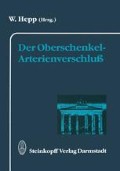Summary
The influence of transcutaneous oxygen- and carbondioxide pressure was investigated during a single application of PGE1 (40 mg/50 ml NaCl-solution/ 4 h i.v) in 21 patients with “critical ischemia” of the lower limb. An improvement of tcp O2 did not occur, and only the increased levels of tcp CO2 significantly diminished. Limb salvage was only possible by normal revascularization.
Access this chapter
Tax calculation will be finalised at checkout
Purchases are for personal use only
Preview
Unable to display preview. Download preview PDF.
Literatur
Bisler H, Montag H (1986) Die intravenöse Buflomedil-Therapie bei arterieller Verschlußerkrankung im Stadium IV. In: Trübestein G (Hrsg) Konservative Therapie arterieller Durchblutungsstörungen. Thieme, Stuttgart New York, S 86
Böhme H, Brülsaver M, Härtel U, Bollinger A (1987) Kontrollierte Studie zur Wirksamkeit von i.a. PGE1 Infusion bei peripherer arterieller Verschlußkrankheit im Stadium III und IV Vasa (Suppl) 20: 206–208
Böhme H (1992) Die konservative Therapie des ausoperierten Gefäßpatienten im Stadium III und IV. In: Schütz RM, Bruch HP (Hrsg) Der ausoperierte Gefäßpatient — Fakten und Perspektiven. 13. Norddeutsche Angiologentage, S 48
Coffmann JD, Mannik JA (1972) Failure of vasodilator drugs in arteriosclerosis obliterans. Ann Intern Med 76: 35–39
Eklund AE, Eroksin G, Olsson AG (1982) A controlled study showing significant short term effect of prostaglandin E1 in healing of ischemic ulcers of the lower limb in man. Prostaglandins Leikot Med 8: 265–271
Folkow B (1967) Pathophysiological aspects of blood flow distal to an obliterated main artery with special regard to the possibilities of affecting the collateral resistance and the arterioles in the distal low-pressure system. Scand J Clin Lab Invest (Suppl) 99: 211–218
Gillespie JA (1966) An evaluation of vasodilator drugs in occlusive vascular disease by measurement. Angiology 17: 280–288
Heidrich H (1992) Diskussionsbeitrag, 7. Berliner Gefäßchirurgisches Symposium, Berlin
Kiesewetter H, Jung F (1992) Rheologische Therapie bei inoperablen arteriellen Durchblutungsstörungen. In: Schütz RM, Bruch HP (Hrsg) Der ausoperierte Patient — Fakten und Perspektiven. 13. Norddeutsche Angiologentage, S 56
Lassen NA, Westling H (1969) Blood flow in the low-pressure vascular bed distal to an arterial occlusion. Scand J Clin Lab Invest 24: 97 — 100
Lill G, Halasa H (1987) Intravenöse Prostaglandin ErTherapie bei Patienten mit arteriellen Verschlußerkrankungen. Med Welt 51 /52: 1699
Pardy JB, Lewis JD, Eastcott HHG (1980) Preliminary experience with prostaglandins E1 und I2 in peripheral vascular disease. Surgery 88: 826–832
Scheffler P, de la Hamette D, Leibnitz G, Gross J (1991) Einfluß einer intravenösen Behandlung mit Prostaglandin E1 auf Blutfluß und Mikrozirkulation: Eine placebokontrollierte Doppelblindstudie an Patienten mit kritischer Ischämie. In: Diehm, Sinzinger, Rogatti (Hrsg) Prostaglandin E1 Springer, Berlin Heidelberg, S 91
Schuler JJ, Flanigan DP, Holcraft JW, Ursprung JJ, Mohrland JS, Pyke J (1984) Efficacy of prostaglandin E1 in the treatment of lower extremity ischemic ulcers secondary to peripheral vascular occlusive disease. J Vase Surg 1: 160–170
Teiles GS, Campbell WB, Wood RFM, Collin J, Baird RN, Morris PJ (1984) Prostaglandin E1 in severe lower limb ischaemia: a doubleblind controlled trial. Br J Surg 71: 506–508
Trübestein G, Ludwig M, Diehm C, Gruss JD, Horsch S (1987) Prostaglandin E1 bei arterieller Verschlußkrankheit im Stadium III und IV. 112: 955–959
Author information
Authors and Affiliations
Editor information
Editors and Affiliations
Rights and permissions
Copyright information
© 1993 Dr. Dietrich Steinkopff Verlag, GmbH & Co. KG, Darmstadt
About this paper
Cite this paper
Jaeschock, R.R. (1993). Transkutane O2- und CO2-Messung nach i.v.-Gabe von PGE1 bei „kritischer“ Ischämie der unteren Extremität. In: Hepp, W. (eds) Der Oberschenkel-Arterienverschluß. Berliner Gefäßchirurgische Reihe, vol 5. Steinkopff. https://doi.org/10.1007/978-3-642-72499-2_7
Download citation
DOI: https://doi.org/10.1007/978-3-642-72499-2_7
Publisher Name: Steinkopff
Print ISBN: 978-3-642-72500-5
Online ISBN: 978-3-642-72499-2
eBook Packages: Springer Book Archive

